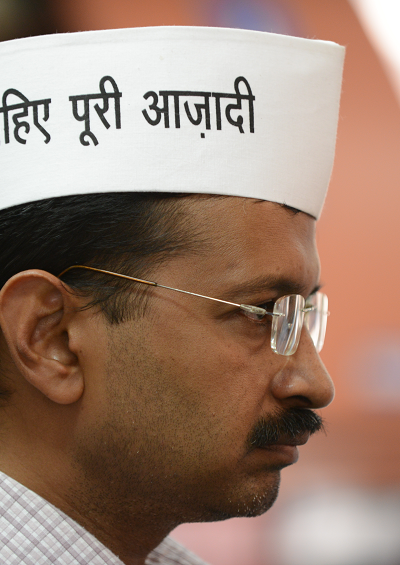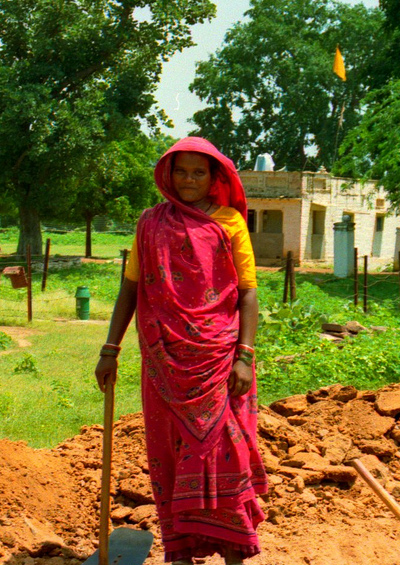India’s Maidan Moment: A Sea Change for Politics?
In Delhi, the Common Man Party finally tries to tackle the inequities of the world’s largest democracy.
February 15, 2015

In his acceptance speech as Chief Minister of Delhi state government in Ramlila Grounds, the “maidan” of the people’s movement which birthed the Aam Admi Party in India just over a year ago, Arvind Kejriwal confided that it was God who had ordained the Tsunami-like landslide win of the AAP (which gained 96% of the available seats).
None of the 100,000 supporters gathered there doubted for a minute that this was indeed so. For them, Kejriwal is indeed a God-sent savior.
His task is to protect them from the ugly corruption of state agencies, the morbid face of the traditional parties in Delhi and the lop-sided “development” which leaves 60% of Delhi’s citizens living in muck and filth.
They are without water or sewage systems, although electricity supply has improved significantly, post privatization by the previous Congress government.
Kejriwal still concludes his speeches with a rousing “Inquilab zindabad” (“Long live the revolution”), which is preceded by Bharat Mata Ki Jai (Praise be to Mother India) and followed by Vande Matram (the title of India’s National Song).
Maturing in his role
But it is clear that political experience has mellowed him. Signs of maturity include a firm rejection of the recently voiced ambitions of several AAP members to ignite AAP “fires” all over the country and spread the party – a mistake they committed last year.
Instead, Kerjiwal made a commitment that he will personally serve the people of Delhi for the full five years. This is also a reality check on the speed at which citizens should expect change. He also reached out to non-supporters with the assurance that he would be everyone’s Chief Minister, not just the AAP’s.
The Common Man Party (AAP) is clearly a new-age substitute for the erstwhile Congress — minus its dynasty, corruption, clunkiness and equipped with a dash of the Communist zeal for equity.
This weekend, for the first time in four decades, the Gandhi cap — a boat shaped headgear of white coarse cotton — was once again the headgear of choice in Ramlila Grounds.
A sea of 100,000 white Gandhi caps, emblazoned with the iconic jhadoo (broom) symbol of the AAP bobbed about. This simple instrument of defiance and political empowerment, dating back to India’s independence struggle, was proudly donned by all present.
Weakness in the cabinet
How long can the romance and dedication of a few drive a government to deliver? This is what remains in doubt.
The cabinet line-up is unremarkable. Four of the six Ministers are newcomers to both politics and government administration.
Kejriwal pledged that he and his team would work 24/7 for the people without rest. But this is meaningless hyperbole. Everyone knows that efficient governments are run not by tireless people, but by efficient systems and institutions, both of which remain in short supply.
Kejriwal also mentioned that the government would seek the advice of Bhen (Sister) Kiran Bedi (the BJP-nominated candidate for Chief Minister who was humiliatingly defeated by the AAP) and Ajay Makken of the Congress. One hopes he will also seek more professional help to flesh out his 70-point manifesto.
Service delivery is, of course, priority number one. Water, sewage and transport are directly within the Delhi government’s ambit and should be Kejriwal’s main focus if he wants to show performance. In the electricity sector, the private utilities have consistently improved their performance.
Upping the stakes
In contrast, policing, housing and land management are not within the mandate of the Delhi government. As a result, these matters cannot be among the AAP government’s priorities, even though reforms are important here too.
At best, Kejriwal can and should be a spokesperson for the citizens and press the Union (=federal) government to perform much better on these issues.
Setting specific targets for water supply, sewage disposal and treatment and travel time in Delhi should be right in the comfort zone of what the IIT alumni who make up much of the AAP should be able to deliver on.
Either way, now is the time for them to descend from the realm of high rhetoric and morality into the mucky business of unclogging the pipes of Delhi’s governance.
For Kejriwal and the AAP, the performance metrics – and the voters’ expectations – are pretty clear-cut:
1. Deliver clean water at a reasonable price to all.
2. Ensure that every dwelling and mohalla in Delhi gets a sewage collection system.
3. Ensure that Delhi’s sewage is treated before it is discharged into the Jumna river.
4. Ensure that public transport is available within a ten minute walk of every dwelling in Delhi at a frequency of not more than 15 minutes during peak hours, 30 minutes during off-peak hours and 60 minutes all through the night.
If you can do this, sir, in 2020 you are sure to get 99% of the seats, possibly with the BJP choosing not to contest.
Takeaways
In Delhi, the Common Man Party finally tries to tackle the inequities of the world’s largest democracy.
This weekend, for the first time in four decades, the Gandhi cap was the headgear of choice in Ramlila Grounds.
A new leader in #Delhi promises a brighter future. Can he deliver? #ArvindKejriwal #India
The AAP must delve into the mucky business of unclogging the pipes of Delhi’s governance.
